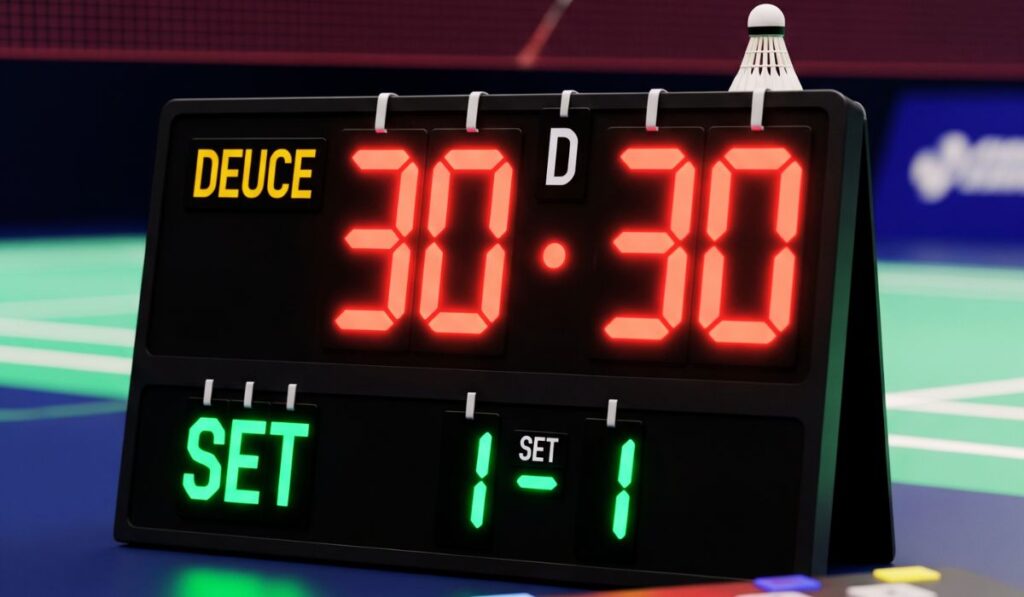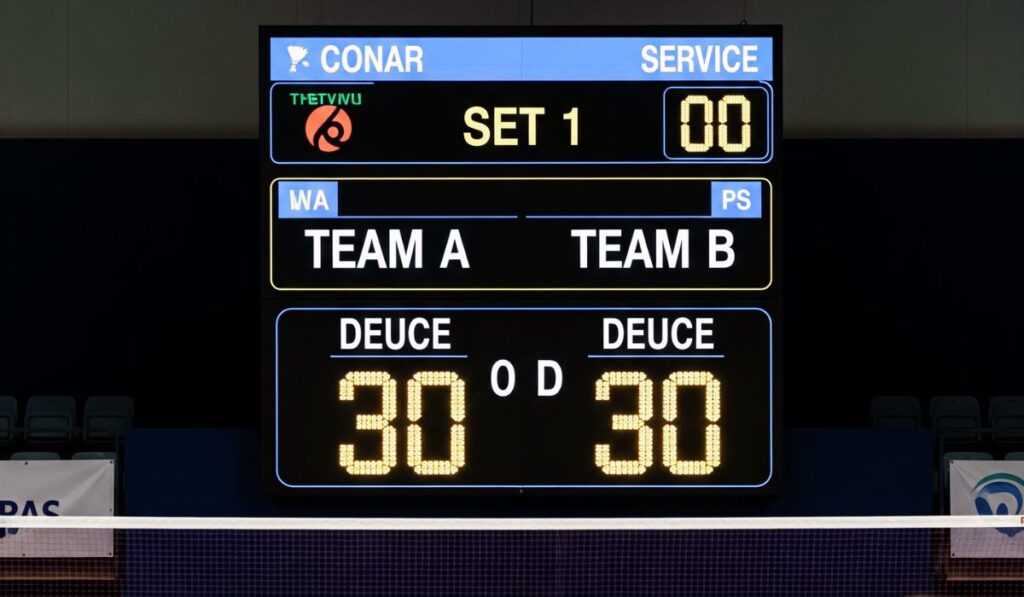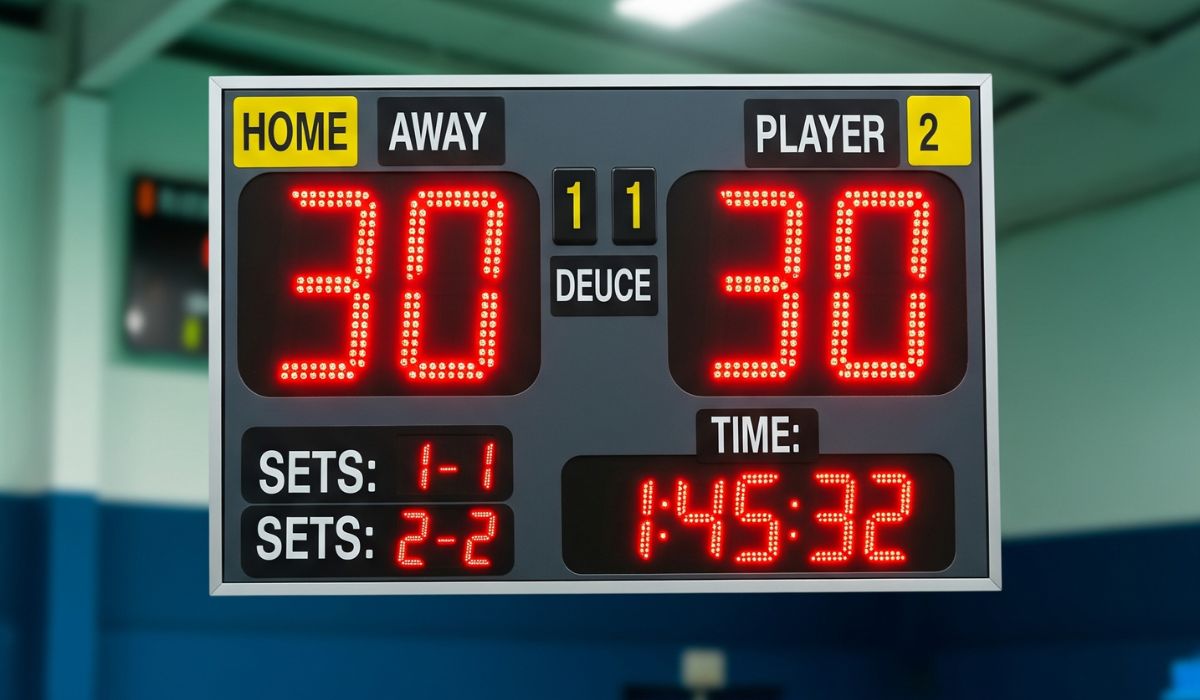Maximum Deuce in Badminton – The Unseen Drama Behind the Scoreboard
Badminton is not just about smashing the shuttle and claiming quick points—it is also a test of endurance, patience, and mental steel. One of the most intense, nail-biting scenarios you can witness in this sport is the maximum deuce in badminton. It is the point in a match where time seems to slow down, where every rally feels like an eternity, and where the outcome swings wildly with every flick of the wrist. For the players, it is both a moment of hope and a nightmare of pressure. For the spectators, it is a rollercoaster of anticipation and disbelief.
The concept of a “maximum deuce” may sound simple on paper—two players or pairs tied at 20-20, pushing each other beyond the regular scoring until someone wins by a two-point margin. But in reality, it’s a war of wills. The court becomes a battlefield, the shuttle becomes a weapon, and every movement is charged with desperation and desire. When the score keeps stretching—22-20, 23-21, 24-22—the match transcends ordinary competition. And when it reaches that legendary Maximum deuce in badminton of 30 points, it becomes the stuff of history.
The Rules Behind the Maximum Deuce in Badminton
To truly appreciate the drama of the Maximum deuce in badminton, you must understand the rules that govern it. In modern badminton, each game is played to 21 points under the rally point scoring system. At 20-20, the game continues until one player or pair gains a two-point lead. This is known as a “deuce” situation. However, there’s a limit—if the score reaches 29-29, the very next point decides the game. This means the highest possible score in a single game is 30-29.
That “final point” at 29-all is pure adrenaline. No matter how skilled or dominant a player may have been earlier in the game, everything boils down to one rally. Every heartbeat feels like a drum inside your chest, every breath is measured, and every swing of the racket carries the weight of victory or defeat.
When the Deuce Turns into a Battle of Nerves
The maximum deuce in badminton isn’t only about physical stamina—it’s an emotional marathon. Imagine rally after rally, with neither player willing to give an inch. Sweat drips into your eyes, your lungs burn, and your hand trembles slightly on the racket handle. The crowd gasps with every shot, sensing the tension rise like a storm cloud ready to burst.
In these moments, mistakes are born not from lack of skill, but from the pressure of knowing that one wrong decision could end the game. Players start to read each other more deeply—anticipating smashes, faking drop shots, and playing mind games that can be more exhausting than the rallies themselves.
The Historical Thrill of the Longest Games
Some of the most unforgettable moments in badminton history have come from games that pushed to the maximum deuce. There have been matches where both players traded blows up to the 30-29 limit, leaving audiences breathless. These aren’t just physical achievements—they’re psychological victories, where mental grit mattered as much as racket speed.
In major tournaments like the All England Open, the BWF World Championships, and the Olympics, maximum deuces have turned underdogs into legends. The player who refuses to fold under pressure often emerges not only as the winner of the match but as a symbol of resilience for fans worldwide.

The Psychological Side of Maximum Deuce
When you’re playing at 28-28, the mental strain is almost unbearable. You’re calculating shot placement while suppressing the urge to take unnecessary risks. You’re fighting fatigue, yet you need to stay explosive for sudden smashes. Your ears are ringing from the crowd’s cheers, yet your mind is locked in an intimate duel with your opponent’s.
This is where great champions separate themselves from good players. Some thrive under this crushing tension, feeding off the intensity to produce shots they didn’t even know they were capable of. Others crack under the pressure, handing victory to their opponent with an unforced error or a misjudged drop.
Why Fans Love the Maximum deuce in badminton
To a badminton fan, nothing is more electrifying than a game that goes the distance. Every extra point feels stolen, every rally a mini-battle. The sound of the shuttle slicing through the air, the squeak of shoes on the court, and the roar of the crowd create an atmosphere that feels almost cinematic.
When the score reaches 29-all, you can almost hear the collective breath being held in the stadium. Fans know they are witnessing something rare—something that will be remembered long after the final shuttle hits the floor.
The Physical Demands of Reaching Maximum deuce in badminton
A normal badminton rally might last 10–15 seconds, but during a maximum deuce, rallies can stretch into 30 seconds or more, repeated over and over. Players sprint to the front of the court for delicate net shots, then leap to the backline for booming smashes, sometimes in the same rally.
The toll on the body is immense—calf muscles scream from lunging, shoulders ache from repeated smashes, and lungs fight to keep pace with the oxygen demand. This is why reaching maximum deuce is as much about conditioning as it is about talent.
Maximum Deuce as a Strategic Game
Contrary to what some might think, the longest games aren’t just endless exchanges of smashes. In fact, strategy plays a bigger role as fatigue sets in. Players begin to conserve energy, using drop shots and clears to control the pace. They also exploit their opponent’s weaknesses—targeting the backhand, forcing awkward body positions, or drawing them into uncomfortable parts of the court.
Experienced players use the deuce as a psychological weapon. They know that dragging an opponent into the 27–28 point range increases the chance of mental mistakes. At that level, even the most confident player can start to doubt their next move.
Memorable Maximum Deuce Matches
Some legendary encounters have showcased the beauty and brutality of the maximum deuce. In one memorable match during the BWF Super Series, a men’s singles game ended 30-29 after a relentless 72-shot rally in the final point. Both players collapsed to the court—one in triumph, the other in sheer exhaustion.
Women’s singles and doubles have also produced iconic maximum deuces, often highlighting the precision and tactical depth of the game. These moments are immortalized not only in highlight reels but also in the memories of every fan who witnessed them.
The Emotional High of Winning a Maximum Deuce
Winning a game at 30-29 is unlike any other victory. The moment the final point is won, adrenaline floods your body, washing away the fatigue. The crowd’s roar becomes a wave of pure energy. For the victor, it’s proof that they could endure the pressure, outlast the opponent, and claim glory in the most dramatic fashion possible.
But for the loser, the heartbreak is magnified. To fight so hard, to come so close, only to fall at the last hurdle—it’s a wound that can take a long time to heal.
Training for Maximum deuce in badminton Situations
Elite badminton players prepare for maximum deuce scenarios in their training. They simulate high-pressure situations, play extra-long rallies, and practice mental focus under fatigue. Interval training, shadow movements, and match simulations are all part of building the endurance and mental sharpness needed to survive these moments.
Some coaches even use psychological drills—forcing players to start practice games at 20-20—to build comfort with the stress of deuce play.
How Maximum deuce in badminton Defines Greatness
The ability to win in a maximum deuce situation often separates champions from contenders. It’s a test that goes beyond technique—demanding mental resilience, emotional control, and sheer willpower. Players who consistently win these battles earn reputations as “big-point players,” feared for their ability to rise when the stakes are highest.
From Club Matches to the World Stage
While maximum deuces are celebrated on the world stage, they happen at all levels of badminton—from casual club games to school tournaments. Even in a friendly match, pushing each other to 30-29 brings out the best and worst in players. For some, it’s a fun challenge. For others, it’s a taste of the emotional pressure professionals face.
The Beauty and Pain of Maximum Deuce in Badminton
The maximum deuce in badminton is a rare blend of agony and ecstasy. It pushes players to their absolute limits, both physically and mentally. It creates stories that fans tell for years and moments that players never forget. It’s a reminder that in badminton, as in life, the hardest battles often lead to the sweetest victories.
There’s a moment in badminton that every player both dreams of and fears — the maximum deuce. It’s that intoxicating mix of exhaustion and adrenaline where your heartbeat feels louder than the crowd, your grip on the racket feels both slippery and electric, and your mind is torn between hope and desperation. Maximum deuce is not just a scoreline; it’s an emotional battlefield where every rally could make or break your story. The clash of rackets, the squeak of shoes on court, and the collective gasp of the audience turn into an unforgettable sensory experience. Winning at maximum deuce feels like being lifted to the heavens. Losing? It’s like being dropped into ice water after thinking you’d finally touched the sun.
Why Maximum deuce in badminton Is the Ultimate Test of Mental Strength
In badminton, a normal rally tests your skills. A maximum deuce tests your soul. At that point, it’s no longer just about smashing harder or defending better — it’s about controlling your emotions when your hands tremble, your lungs burn, and your opponent’s eyes dare you to blink first. Every point becomes a war of nerve control, and the player who remains calm under this storm is usually the one who writes history.
The Rule That Creates This Tense Drama
To understand why maximum deuce holds so much drama, you need to know the rule. In singles or doubles, a game is usually played to 21 points. But if the score reaches 20–20, you must win by two clear points. This can go on until someone reaches 30 points — the absolute ceiling. That final number, 30, is the maximum deuce. No second chances. No more cushion. Whoever wins the next point, wins the game. It’s sudden death with a poetic twist.
The Physical Toll of Reaching 29–29
By the time a match gets to 29–29, your muscles feel like molten lead. Your lungs scream for oxygen, and sweat drips into your eyes, blurring your vision. Yet, strangely, you also feel invincible. Every fibre of your body has been pushed to the edge, and somehow, you keep going because you know you are about to etch your name into this match’s memory forever.
A Seductive Dance Between Attack and Defense
At maximum deuce, rallies become slow-burning seductions. You lure your opponent into the backcourt, tempt them into overreaching, and then twist the knife with a sudden drop shot. Every swing of the racket is like a whispered promise — or a cruel lie. The smartest players don’t just hit shots; they create mind games that unravel their opponent’s rhythm.
Crowd Energy Becomes a Second Opponent
The roar of the crowd at 29–29 can lift you or crush you. Some players feed on that electricity, letting it pump courage into their veins. Others feel the pressure of hundreds of eyes drilling into their every move. Each cheer, each gasp, feels amplified, and the weight of expectation can be heavier than the racket itself.
The Split Second Between Triumph and Despair
There’s nothing quite like the final point of Maximum deuce in badminton. You leap for a smash, or dive for a desperate save, and in that heartbeat before the shuttle lands, the whole world holds its breath. When it hits the floor on your opponent’s side, you explode with joy. If it lands on yours, the silence feels deafening.
Legendary Maximum deuce in badminton Matches
Some of the greatest badminton stories have been forged in the fires of Maximum deuce in badminton. Matches where neither side gave up, where both players refused to blink first, and where the final rally was so breathtaking it became immortal. In these moments, technique and fitness matter, but grit and belief matter more.
Emotional Scars and Sweet Memories
Winning at maximum deuce feels like drinking from a fountain of pure victory. Losing at Maximum deuce in badminton? That memory lingers. You replay that last rally in your mind, asking yourself if you could have taken one extra step, one cleaner shot, one braver decision. Those scars can hurt for years — or fuel your comeback story.
How Strategy Changes at Maximum deuce in badminton
When you’re at 29–29, it’s not just about your strongest shot — it’s about your smartest shot. Players often shift from flashy smashes to safer, high-percentage plays. They avoid unnecessary risks but stay aggressive enough to seize opportunities. The rally becomes a chess match played at lightning speed.
The Role of Fitness in Lasting This Long
Maximum deuce in badminton rewards the well-prepared. Players with superior stamina and explosive recovery speed can keep playing high-intensity rallies without losing accuracy. That’s why elite athletes treat fitness as a secret weapon — because at 29–29, a tired leg or a lazy swing can mean the end.
Mental Rituals to Survive the Pressure
Some players use deep breathing, towel breaks, or intense eye contact with their coach to reset their mind before the final point. Others have personal rituals — bouncing the shuttle three times, squeezing the grip tighter, or replaying their happiest victory in their head — to block out fear.
The Beauty of Mutual Respect
When you and your opponent reach Maximum deuce in badminton, you’ve both just shared one of the most intense experiences in sports. Often, after the final point, even bitter rivals exchange smiles or hugs. There’s a deep, unspoken respect because you both know you’ve been through the same fire.

Why Fans Love Watching Maximum Deuce
For spectators, Maximum deuce in badminton is the ultimate high. Every rally has the potential to end the game, so the tension is almost unbearable. Fans love that unpredictability — the possibility that a single slip could flip the outcome entirely. It’s the kind of sporting drama that glues you to your seat.
Maximum deuce in badminton as a Career-Defining Moment
Some players become legends because of a single maximum deuce victory. That one game becomes part of their identity, replayed in highlight reels and talked about in interviews for years. Others are remembered for a heartbreaking loss that made them hungrier for the next big win.
The Physical Soundtrack of Maximum deuce in badminton
If you close your eyes during a Maximum deuce in badminton rally, you’ll hear a unique symphony — the rhythmic thud of shuttle against strings, the squeak of shoes on the court, the sharp exhale with every smash, and the sudden silence before the crowd erupts. It’s sports music in its purest form.
The Psychological Rollercoaster
Your emotions during maximum deuce swing violently — confidence, doubt, excitement, fear — all in seconds. The ability to control that rollercoaster is what separates champions from the rest. Even the smallest lapse in focus can cost you the match.
How Maximum Deuce Shapes Young Players
For rising athletes, experiencing maximum deuce early in their career is a powerful lesson. It teaches patience, resilience, and the value of staying calm under crushing pressure. Many coaches see it as a rite of passage into serious competition.
Famous Rivalries Born in Maximum deuce in badminton
Some of badminton’s fiercest rivalries have been born from epic maximum deuce battles. Those matches plant seeds of unfinished business that grow into legendary showdowns in future tournaments.
The Aftermath — Joy or Emptiness
After Maximum deuce in badminton, emotions don’t just fade — they crash. Winners feel invincible, walking off the court with their head high and chest proud. Losers often sit in silence, processing what just happened, the taste of sweat and regret mingling in their mouth.
The Eternal Allure of Maximum deuce in badminton
Even if you’ve played thousands of matches, the magic of Maximum deuce in badminton never fades. It’s a reminder of why badminton is both beautiful and cruel — because the same moment that can give you your proudest memory can also deliver your deepest heartbreak. And that, perhaps, is why we keep coming back for more.


1 thought on “Maximum deuce in badminton”